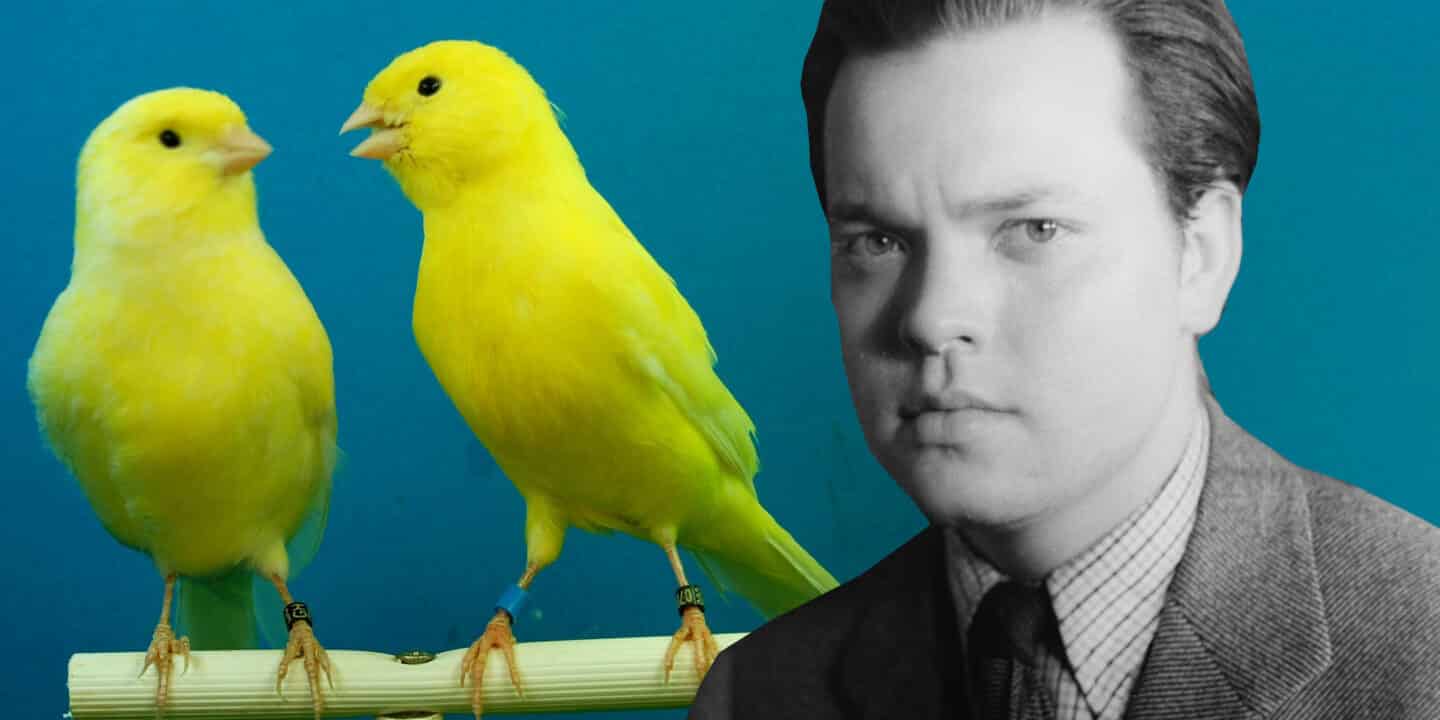Charles Foster Kane. Sir John Falstaff. Captain Hank Quinlan. In a just world, the character Trunk Frost would be included in this list of legendary characters Orson Welles immortalized via celluloid. Welles is perhaps American cinema’s greatest auteur, but like many artists before him, he was unable to get his ultimate passion project off the ground.
Here are five reasons why audiences never got to experience Orson Welles’ long-lost film (Ruffle My Feathers, Sweetheart!) in which a tap-dancing canary falls in love with a human man.
Welles Insisted On Playing Both the Canary and the Human
Initially, Columbia Pictures agreed that Welles would play the role of Trunk Frost, a playboy pilot who dreamed of one day soaring through the skies without his airplane, and Rita Hayworth would play Peanut, the rhythm obsessed canary with whom Trunk forms an intense romantic connection. However, at some point, Welles began to doubt that Hayworth was up for the role, and decided he should play it himself.
This complicated matters for Welles’ physicality, as he had to prepare his body to play Captain Frost, a 300-pound bodybuilder, but also slim down to a lean 75 pounds to play Peanut. The weight fluctuations nearly killed Welles and made the insurance for the project skyrocket, angering the studio.
Welles Refused to Start Shooting Until He Spent Two Decades Studying the Birds on the Canary Islands to Inform His Performance
Leonardo DiCaprio spent his life preparing to be the Wolf Of Wall Street by having a lot of sex so that when he did it on screen, you could tell it made him feel really good. If only Orson Welles had been awarded the same opportunity to adequately research his role, my dorm room may have had a different poster hanging above my micro-fridge.
Regardless, living on the Canary Islands led to Welles permanently adopting the Island Time mentality, a mindset completely incompatible with the rigorous shooting schedule necessary to make a Hollywood film.
Welles Wanted the Film to Take Place in the Looney Tunes Universe So He Could Canonically Kill Tweety Bird
Through films like The Magnificent Ambersons, F for Fake, and The Trial, Welles solidified his status as an artist with something to say. However, few people know that the ultimate message that the auteur wanted to convey was that Tweety Bird deserves to die.
In interviews, Welles would often assert that Tweety Bird belongs in Hell for exploiting Sylvester’s desire to protect the home. Unfortunately, since the Looney Tunes were owned by Warner Brothers, who was not interested in the film because they thought Welles should be playing five or six roles instead of just two, the director was unable to depict Tweety’s death in the way he intended (natural causes).
Welles Kept Blaming His Inability to Tap Dance in Iambic Pentameter On His Tap Shoes (Which Were Perfectly Good)
Unsurprisingly, Welles wanted to imbue Ruffle My Feathers, Sweetheart! with the Shakespearean grandeur of his most ambitious works. This, of course, manifested in Welles’ decision to have Peanut tap dance exclusively in iambic pentameter. It took an army of 70 PAs to purchase and inevitably return the thousands of tap shoes Welles tried on for the role, as he would find fault with each one even though it was clear they were all really nice tap shoes. It wasn’t until a rumor began circulating that Welles wanted to have his beard hair replaced with Shirley Temple’s hair because he believed it would make him a better tap dancer that the studio got involved and put a stop to it.
Welles’s House Became Infested With Moths Who Kept Eating the Pages of the Script That Had All the Funny Jokes on Them
Ask any writer and they will tell you that the enemy of creativity is the common clothes moth, whose favorite treat (besides clothes) is the written word. Unfortunately for Orson, these pests especially love funny jokes, and they devoured all the laugh out loud scenes almost as fast as he could type them.
Welles later lamented that he rewrote the funniest scene every night for six weeks straight only to wake up the next morning and discover the moths had once again feasted upon it. The scene involved Trunk Frost getting kicked in the groin and Peanut turning to the camera to say, “That’s gotta hurt!” This, in conjunction with the other misfortunes that had befallen the project, led to Welles finally giving up on the film, depriving audiences of another masterpiece.



